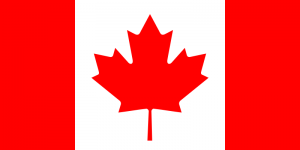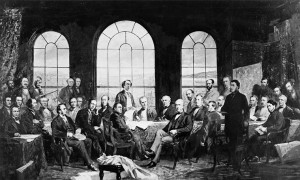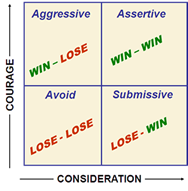Canada: Peace, Order, and Good Government
 Happy Birthday, Canada! On July 1, 2013 Canada has officially been a country for 146 years.
Happy Birthday, Canada! On July 1, 2013 Canada has officially been a country for 146 years.
As one who was born and raised in Canada and then moved to the United States at the age of 38, I write from firsthand experience when comparing these two countries. America is known as the land of the free. Canada is known as the land of compromise.
While there are many similarities to these two countries, they are vastly different. One need only study the banking system, the healthcare system, and the political system to begin to appreciate the differences between these two countries.
A Comparison of Values
The major differences between Canada and the United States are clearly evident by studying the different values (the very reason I write, speak, and consult). Consider the 3 differentiating values of these two countries.
- Canada: peace, order, and good government.
- America: life, liberty, and the pursuit of happiness.
When comparing Canada and the United States, there is a LOT that can be explained by the differences in these values. Considering Canada’s values, it shouldn’t surprise anyone that the country is known as the land of compromise.
While I have not (yet) defined a value for ‘good government’, the values for peace and order have been defined, as follows:
- Peace means harmonious relations; freedom from disputes.
- Order means bringing into conformity with rules or principles or usage.
It could be said that ‘good government’ is all about maintaining peace by enforcing conformity with a set of principles. In Canada, this is where the focus of most discussions occur – defining the principles.
Studying the Division of Power
 The Constitution Act, 1867 is a major part of Canada’s constitution. It defines much of the operation of the Government of Canada, including its political structure, system of justice, and taxation. It also defines the division of powers between the federal government and the provinces.
The Constitution Act, 1867 is a major part of Canada’s constitution. It defines much of the operation of the Government of Canada, including its political structure, system of justice, and taxation. It also defines the division of powers between the federal government and the provinces.
Generally, the federal parliament and the provincial assemblies operate independently of one another, in their respective legislative authority. For instance, the federal government looks after foreign affairs and telecommunications, while education and healthcare fall within provincial jurisdiction. A few areas fall within a shared federal-provincial responsibility, including agriculture and immigration.
The same could be said of the division of powers in the United States, between the federal and state governments. However, most historians agree that the decades-long political struggles between advocates of strong state powers versus proponents of federal supremacy were the real trigger for the American civil war (1861-1865). Though often regarded as a war over the question of slavery, the Civil War actually was fought over the age-old argument of power. The southern state leaders thought of their territories as sovereign in and of themselves. However, the Union victory (at the cost of 600,000+ dead soldiers) solidified the power of a federal government.
Not surprisingly, it was against this backdrop of the Civil War in America, that Canada’s first Prime Minister, John A. MacDonald, changed his stance on the division of power, and decided to support a federal system. His goal was to avoid violent conflicts by maintaining a fusion of powers rather than a separation of powers.
Thus, in addition to the birth of a great country, the great Canadian diplomacy machine was born, for which it is well known today.
Political Marketing: Propaganda, Diplomacy, & Compromise
Most people don’t think of governments as marketers. Yet, just like any other organization, politicians are marketing their ideas, policies, and programs all the time. When we like what is being offered, we call it “good government.” And when we don’t like what is being offered we call it propaganda, which is making statements that may be partly false or partly true, with the sole purpose to influence the attitudes of people. In all cases, it’s purely political marketing.
Then there is the art of diplomacy.
Diplomacy is the practice of conducting negotiations between representatives of groups or states. While this is usually associated with international relations, it also applies to “intra-national” relations, that is, between provinces/states and the federal government. Canadian politicians have 146 years of experience practicing diplomacy and negotiation (and propaganda).
 Consider that in any negotiation between two parties, there are 4 possible outcomes:
Consider that in any negotiation between two parties, there are 4 possible outcomes:
– Win-Win – when each side of a dispute feels they have won.
– Win-lose – when only one side perceives the outcome as positive.
– Lose-Win – when only one side perceives the outcome as positive.
– Lose-Lose – when both sides end up being worse off.
To achieve a win-win scenario, agreements or solutions must be viewed as beneficial to both sides. It generally requires tremendous creativity, with a continual belief that there IS a better way. The challenge is in finding it. Unfortunately, most often concessions are made and both parties end up agreeing to compromise.
A compromise is an agreement or settlement that is reached by each side making concessions. Generally, this equates to a Lose-Lose scenario (though no one ever admits to it). However, if the end result is peace and order, and both parties can move forward with their other agendas, then to a Canadian, that is a victory.
Clearly, this is a very different approach from their American allies.
So, if leadership is about influence, and marketing is about persuasion, then Canadians are leaders in marketing that create peace and order where none existed before. Maybe that’s why Canada is often asked to participate in global conflicts in a peacekeeping role.
This also might explain why Canada tops the list as the world’s most reputable country, for the third year in a row.
What does Canada mean to you?
What differences do you see in the values of Canada vs. the United States?
What do you feel is the competitive advantage of Canada’s political system?
Today’s value was selected from the “Harmony-Order” category, based on the e-book Developing Your Differentiating Values.







